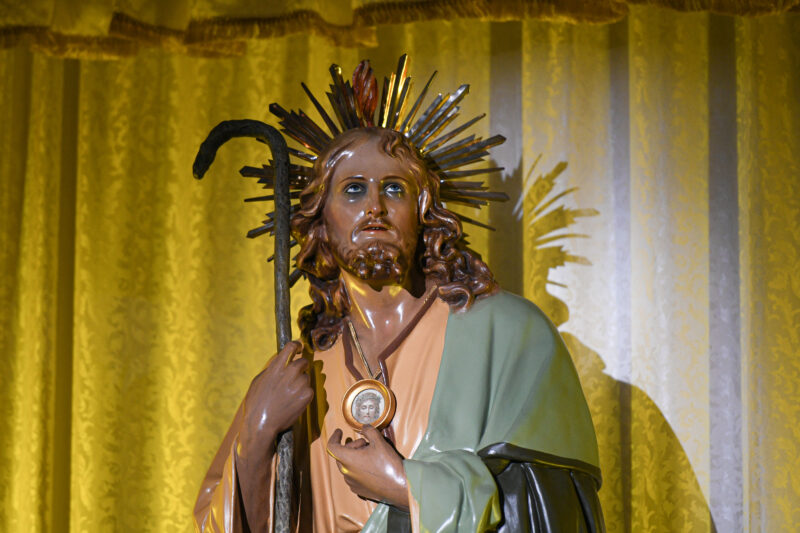I don’t know about you, but I have always been curious about the medallion with an image of Jesus around St Jude’s neck in many of his images. This typical element of St Jude’s iconography is rooted in an ancient legend that goes back to the early Church, at about the fourth century, and recounted by St Eusebius of Caesarea (Historia Ecclesiastica, 1.13).
The legend says that King Abgar of Edessa (a city in modern day Turkey) was ill. When he heard about Jesus, he sent a letter asking for healing and offering him a place of refuge from those who wanted to kill him. Jesus refused to go because of his obedience to the Father’s will. However, Jesus was so impressed by the faith of this king that he wiped his face with a handkerchief on which he left an imprint of his face and sent it to King Abgar, while promising him that after he had suffered his passion and was lifted up, he would send one of his disciples to him. When the king saw this image, he placed it with great reverence in one of the halls in his palace.
One version of this legend states that after Jesus’ ascension into heaven and the descent of the Holy Spirit upon the Apostles, Thaddaeus (St Jude the Apostle) was sent to King Abgar of Edessa, as Jesus had promised. St Jude placed his hands on the King, and he was cured through the power of the name of Jesus. Astonished by this, the King converted to the Christian faith along with all the people in his kingdom.
Although we are not sure if this story did actually take place, it is certain that behind this story there is a hidden truth of great importance that enlightened the life of this holy Apostle and enlightens us in our Christian vocation. St Paul in his Second Letter to the Corinthians, writes:
And all of us, with unveiled faces, seeing the glory of the Lord as though reflected in a mirror, are being transformed into the same image from one degree of glory to another; for this comes from the Lord, the Spirit.
2 Corinthians 3:18
Created in the image of God and adopted as his sons and daughters through baptism, we bear the image of Christ in our souls similar to the image imprinted on the handkerchief, an image that gives us our identity and our dignity. But this image also brings responsibility. Like St Jude, we are sent “with unveiled faces, seeing the glory of the Lord as though reflected in a mirror.” We are called so that, after we allow God’s mercy to be poured into our hearts, we approach our brothers and sisters and share with them this mercy, leading them to healing that can only come about through an encounter with the crucified and risen Christ. The Lord often uses us so that, like St Jude, after allowing the glory of the Lord’s face to rest upon us and gradually transform us into his likeness, we in turn gaze upon others and become instruments in the Lord’s hands by allowing his light to shine upon them through us, we allow him to look upon them with a loving gaze, through concrete gestures of love, a kind word, a loving silence which is ready to listen, and by the time we dedicate to others.
Through the intercession of St Jude, may we allow Christ’s image to be imprinted within us to continually transform us into a more perfect reflection of himself so, even if simply through our gaze or our smile, “with unveiled faces, seeing the glory of the Lord as though reflected in a mirror” upon our world and upon our brothers and sisters in our times.




